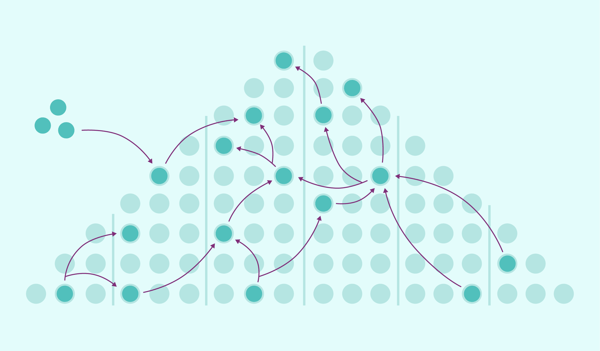Remote Work, Internal Mobility, and Embracing Soft Skills are Key Talent Management Trends in 2021
There was a popular Tweet flying around the internet last summer that summed up the past year perfectly. It said, “Don't know about y’all but I could really go for some precedented times.”
No kidding.
We saw huge shifts in the past year when it came to how we worked and how we lived, and all this change is generating some fascinating new trends around how we’ll approach the people side of work in the future.
Looking ahead, here are 3 big ideas that will shape talent management in 2021:
1. What makes us human matters most
According to the World Economic Forum, 44% of the skills employees will need to perform their roles effectively will change by 2025. Surprising? Not really. We live in a rapidly changing world, and as circumstances change and new technologies emerge, the skills we require change too. Just think about how rapidly most of us unexpectedly became video conferencing experts in the last year. Even your Grandma learned to use Zoom.
But amidst all this AI, automation, and digitization, it’s actually our humanity that has become more prominent and powerful in our day-to-day work. Soft skills like communication, collaboration, decision-making and problem-solving are critical to succeeding in our new work reality. As Josh Bersin writes in his 2021 HR Predictions Report, most of the jobs of the future will emphasize communicating, and helping and caring for others, while also drawing heavily on the ability to listen, collaborate, innovate, and manage through change.

To truly thrive, organizations need to tap into these uniquely human capabilities deep within their talent pools. In its 2021 Global Human Capital Trends report, Deloitte talks about “the importance of organizations collecting and acting on workforce data that provides a real-time view of employees’ skills across the entire talent ecosystem.”
Knowing which employees excel at things like communication and innovation will allow organizations to mobilize talent into critical roles faster, where they can fully utilize their critical behavioral skillsets. And without a doubt, organizations that develop strategies to fully measure and leverage these human capabilities in their workforces will be more resilient as the world continues to evolve.
2. Visibility and mobility are the keys to retaining employees
It’s no secret that career paths are no longer linear. We’ve known for years that instead of climbing up a vertical career ladder, employees are increasingly moving up, down and across the corporate lattice to build meaningful and stimulating careers. In a world of rapid change, it’s unrealistic to expect that employees want to sit still in the same jobs for years, and 60% of millennials say they are open to new job opportunities.
Moreover, despite widespread layoffs in 2020, LinkedIn reports that there are millions of jobs still being posted to their platform, with someone getting hired every three minutes. With critical skill shortages emerging, companies will also be looking to “buy and rent” talent to meet changing business needs. This all means that star performers have no shortage of career options, so providing them with new opportunities to grow is one of the most critical talent retention strategies organizations can implement today.
Internal mobility is all about tapping into an organization’s existing internal talent pool to fill open opportunities. It’s a win-win for both employees and employers. By moving talent into new roles that align with their career aspirations and leverage their strengths, organizations hold onto a vast amount of institutional knowledge, while employees have the opportunity to learn new things and advance their careers.

But facilitating internal mobility is easier said than done for many companies, especially large enterprise organizations, because it’s difficult to gain visibility to the individuals that make up those vast talent pools. How can you move the right people into the right roles at the right time, if you can only see the employees that are right in front of you? How do you know who has the right behavioral competencies for a job, if you have no way of measuring and comparing those competencies against job requirements that are constantly changing?
That’s where technology comes in. Being able to use technology to identify job requirements and measure individual employee talents allows you to break down silos and see the potential that exists deep within your workforce. With this type of data and insights, you can screen people in for opportunities who you never would have seen before. It’s about looking beyond a resume or past experiences alone to understand what employees are truly capable of. Once you can see them and understand what makes them exceptional, you can tap into that exceptional quality to set both the person and the organization up to thrive.
3. Remote work is changing the talent game forever
For years, HR experts have been predicting a widespread shift to remote work, brought on by advances in technology and changing employee expectations around flexibility. Before the coronavirus pandemic threw humanity for a loop in 2020, the future of work was a far-off, abstract idea. Then, last March, we were pulled into the future with lightning speed. Now, nearly a year into our remote working reality, Forrester reports that 53% of North American employees say they want to continue working from home after the pandemic.
For some companies, post-pandemic work will continue to be fully remote. For others, it’s likely that they’ll adopt a hybrid model - allowing employees to split time working from the office and from home. What’s clear amidst all of this ambiguity is that the way we manage talent across the employee lifecycle will be completely different than what we saw pre-pandemic. From hiring, to building high-performing teams, to developing employees, to identifying high-potentials, the way we manage talent will be completely reimagined in a world where remote work remains constant.

We’ve already seen companies adopt fully digital hiring processes - and that won’t change since virtual hiring has seen widespread increases in hiring quality, time savings and improvement at all stages of the talent acquisition journey.
And, in a world where employees are spending more time behind screens and less time together, organizations need to give extra consideration to onboarding new employees and team building. When some people are working in the office and others are working from home, creating trust by understanding each employee’s unique strengths will be critical for building high-performing teams.
Meanwhile, one of the key learnings from 2020, was a shift to more human-centric leadership in organizations. The importance of having empathetic, courageous and purpose-driven leaders became crystal clear as the line between home life and work life was completely blurred. For many organizations, this confirmed the need to identify and develop leaders earlier in their careers to strengthen the pipeline of emerging leadership talent, and to help high-potential employees develop into the kind of leaders needed to thrive in the new world of work.
But if the age-old conundrum of leaders flagging high-potential talent based on who they know, who they like, and who is right in front of them was true pre-pandemic, imagine how much more difficult it is to identify emerging leaders in large, siloed, organizations that are now working 100% remotely?
In 2021, organizations will need to find ways to quantify the potential within their workforces using standard criteria and a universal talent language. They'll need to use technology to spot emerging leadership talent deep within their talent pools, and to create people-centric development plans that allow people to grow into the best versions of themselves.